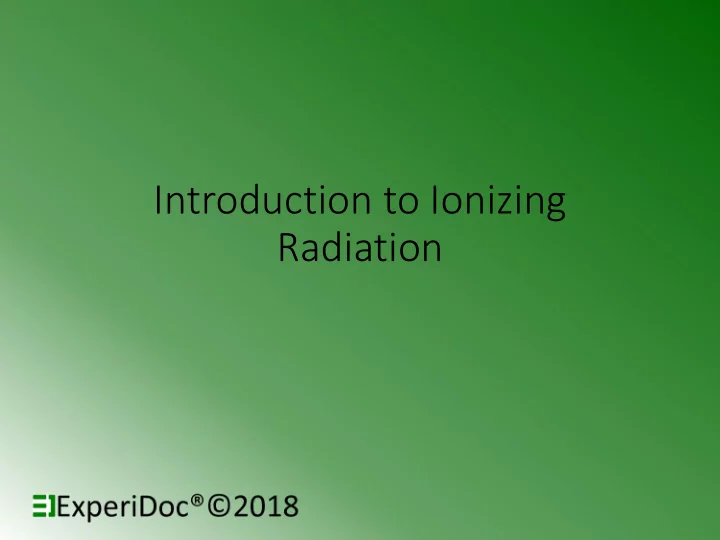

Introduction to Ionizing Radiation
Basic Model of a Neutral Atom • Electrons(-) orbiting nucleus of protons(+) and neutrons. • Same number of electrons as protons; net charge = 0. • Atomic number (number of protons) determines element. • Mass number (protons + neutrons) gives mass in terms of 1/12th mass of Carbon atom.
Ionization vs. Excitation • Excitation transfers enough energy to an orbital electron to displace it further away from the nucleus. • In ionization the electron is removed, resulting in an ion pair. • the newly freed electron(-) and the rest of the atom(+).
Ionizing Radiation • Any electromagnetic or particulate radiation capable of producing ion pairs by interaction with matter. • Scope limited to X and gamma rays, alpha particles, beta particles (electrons), neutrons, and charged nuclei. • Important biologically since media can be altered (e.g., ionized atom in DNA molecule may be altered, thereby causing cell death, or mutation).
Particulate vs. Electromagnetic Radiations • Particulate Radiations are sub-atomic particles with mass (e.g., alpha and Beta particles, electrons, neutrons). • EM Radiations (X-rays and gamma rays) have no mass and no charge.
Electromagnetic Spectrum
High vs. Low Energy Radiation • Absorption of radiation is the process of transferring the energy of the radiation to the atoms of the media through which it is passing. • Higher energy radiation of the same type will penetrate further. • Usually expressed in KeV or MeV • 1 eV = 1.6 x 10 -19 Joules = 1.6 x 10 -12 ergs
High vs. Low Linear Energy Transfer (LET) • LET is measured by the ionization density (e.g., ion pairs/cm of tissue) along the path of the radiation. • Higher LET causes greater biological impact and is assigned a higher Quality Factor(QF). • Example QF values: X, gamma, and beta have QF = 1; alpha QF=20; thermal neutrons QF=3; "fast" neutrons (>10 KeV) QF = 10; fission fragments QF>20.
Alpha Particles (or Alpha Radiation) • Helium nucleus (2 neutrons and 2 protons); +2 charge; heavy (4 AMU). Typical Energy = 4-8 MeV; • Limited range (<10cm in air; 60µm in tissue); • High LET (QF=20) causing heavy damage (4K-9K ion pairs/µm in tissue); • Easily shielded (e.g., paper, skin) so an internal radiation hazard.
Beta Particles • High speed electron ejected from nucleus; -1 charge; light 0.00055 AMU; Typical Energy = several KeV to 5 MeV; • Range approx. 12'/MeV in air, a few mm in tissue; • Low LET (QF=1) causing light damage (6-8 ion pairs/µm in tissue); • Primarily an internal hazard, but high beta can be an external hazard to skin.
Bremsstralung (or Braking) Radiation • High speed electrons may lose energy in the form of X-rays when they quickly decelerate upon striking a heavy material. • Aluminum and other light (<14) materials and organo-plastics are used for shielding.
Positrons • Beta particles with an opposite (+) charge. • Quickly annihilated by combination with an electron, resulting in gamma radiation.
Neutrons • Neutrons ejected from a nucleus; 1 AMU; 0 Charge; • Free neutrons are unstable and decay by Beta emission (electron and proton separate) with T½ of approx. 13 min; • Range and LET are dependant on "speed": Slow (<10 KeV), "Thermal" neutrons, QF=3; and Fast (>10 KeV), QF=10.
Shielding Neutrons • Shielded in stages: High speed neutrons are "thermalized" by elastic collisions in hydrogenous materials (e.g., water, paraffin, concrete). • The “hit” nuclei give off the excess energy as secondary radiation (alpha, beta, or gamma). • Slow neutrons are captured by secondary shielding materials (e.g., boron or cadmium).
X-Rays and Gamma Rays • X-rays are photons (electromagnetic radiations) emitted from electron orbits, such as when an excited orbital electron "falls" back to a lower energy orbit. • Gamma rays are photons emitted from the nucleus, often as part of radioactive decay.
X-rays and Gamma Radiation • Gamma rays typically have higher energy (Mev's) than X-rays (KeV's), but both are unlimited. • No mass; Charge=0; Speed = C; Long range (km in air, m in body); Light damage (QF=1); • An external hazard (>70 KeV penetrates tissue); Usually shielded with lead or concrete.
Radioactive Decay • Matter transforms from unstable to stable energy states. • Radioactive materials are substances which spontaneously emit various combinations of ionizing particles (alpha and beta) and gamma rays of ionizing radiation to become more stable. • Radioisotopes are isotopes (same number of protons but different numbers of neutrons) which are radioactive.
Decay Series
Proton “Gain” during Beta Decay
Beta Decay • No change in atomic mass; protons increase by 1. • Consider a neutron as a proton embedded with an electron; net charge = 0. When the electron is ejected, a proton is "created", thus increasing the atomic number.
Decay Serie ies • Radioactive parent decays to a "daughter" which may also be radioactive, therefore, is also simultaneously decaying. • Resulting exposure is to the combination of both decays (and possibly additional daughters). • Radon daughters are an important example of series decay exposure in uranium mines and basements.
Series Decay
Note common formula structure.
Calibration Source
Recommend
More recommend